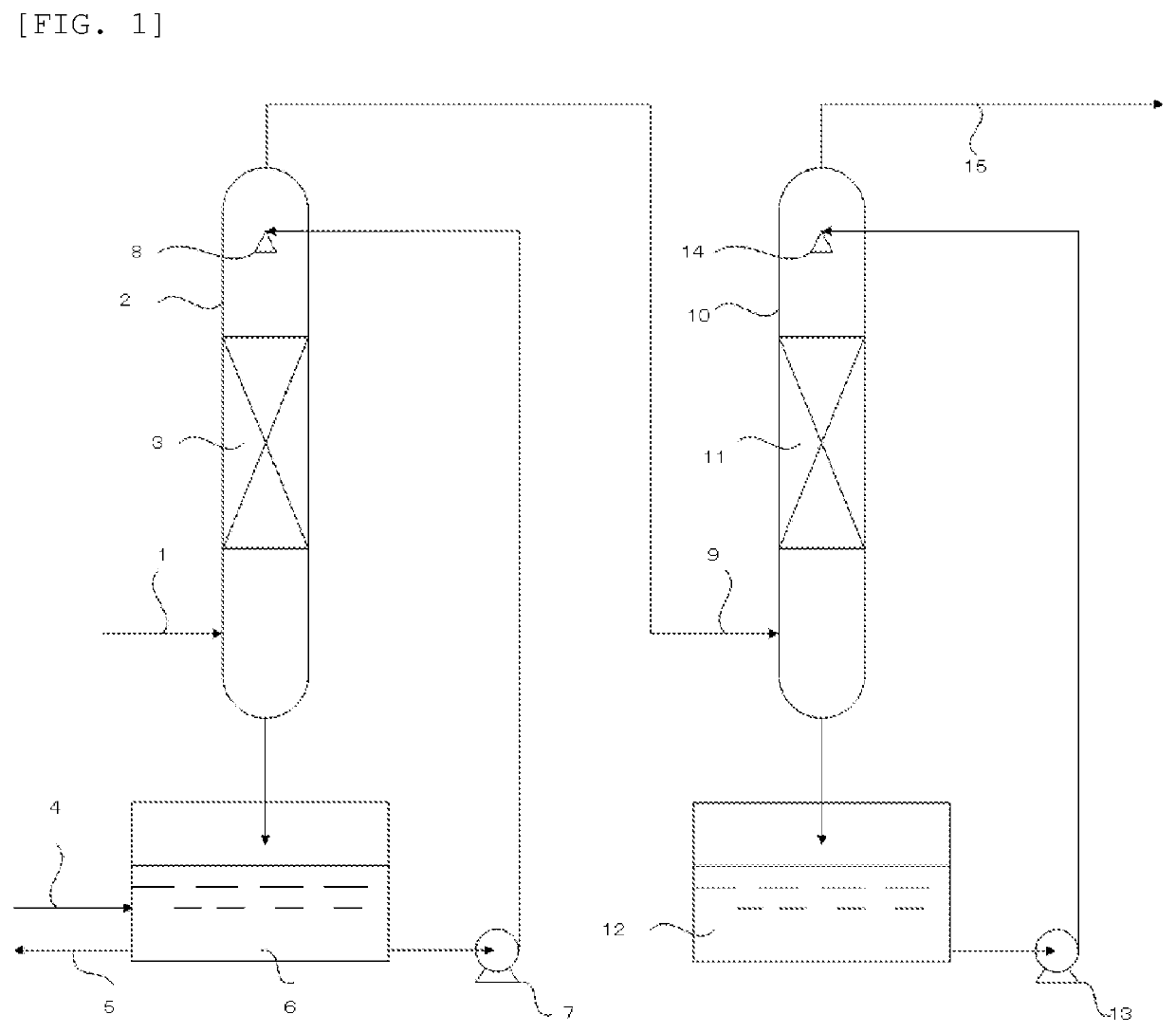Method for treating exhaust gas containing elemental fluorine
a fluorine-based exhaust gas and fluorine-containing technology, applied in the direction of separation processes, dispersed particle separation, chemistry apparatus and processes, etc., can solve the problems of high running cost, high toxicity, and the inability to remove oxygen difluoride once generated by water or alkaline aqueous solution, so as to reduce toxic fluorine-based gases, reduce fluorine-based gases, and efficient treatment of fluorine-containing exhaust gas
- Summary
- Abstract
- Description
- Claims
- Application Information
AI Technical Summary
Benefits of technology
Problems solved by technology
Method used
Image
Examples
example 1
[0059]Treatment of an exhaust gas was performed by using an apparatus equipped with a first absorption column (2) having a diameter of 500 mm in which cascade mini-rings as a filling material were filled at a filling height of 4 m in a filling layer 1(3) and a second absorption column (10) having a diameter of 500 mm in which cascade mini-rings as a filling material were filled at a filling height of 4 m in a filling layer 2 (11). FIG. 1 depicts a schematic diagram.
[0060]At the first step performed on the first absorption column (2) side, water was introduced into a circulation liquid tank 1 (6), and circulated at 4 m3 / hr. The amount of water introduced and the amount of the circulation liquid discharged were adjusted such that an HF concentration in the circulation liquid tank 1(6) was 3% by mass.
[0061]At the second step performed on the second absorption column (10) side, a basic aqueous solution including a reducing agent (pH at charging: 13.5) prepared so that KOH as the base ha...
example 2
[0065]Exhaust gas treatment was performed in the same manner as Example 1 except that, in Example 1, the F2 concentration in the exhaust gas to be treated was 40% by volume. The gas component discharged from the first absorption column (2) and introduced into the second absorption column (10) was a gas including 20,000 ppm by volume of F2, 1,300 ppm by volume of HF, and 42,000 ppm by volume of OF2.
[0066]Table 1 has listed concentrations of respective fluorine-based gas elements in the treated gas discharged from the treated gas discharging pipe (15) and amounts of consumption of chemical solution (the basic aqueous solution including a reducing agent) in the second step. Neither F2 nor HF was detected from the treated gas, and 1 ppm by volume of OF2 was detected therefrom. In addition, the amounts of the chemical solution consumed in the second absorption column (10) were 6.7 kg / hr for KOH as the base and 18 kg / hr for K2SO3 as the reducing agent.
example 3
[0067]Exhaust gas treatment was performed in the same manner as Example 1 except that, in Example 1, sodium thiosulfate (Na2S2O3) was used in place of potassium sulfite (K2SO3), as the reducing agent in the chemical solution (the basic aqueous solution including a reducing agent) used at the second step, and the concentration of Na2S2O3 was set to 3% by mass.
[0068]Table 1 has listed concentrations of respective fluorine-based gas elements in the treated gas discharged from the treated gas discharging pipe (15) and amounts of consumption of chemical solution (the basic aqueous solution including a reducing agent) in the second step. Neither F2 nor OF2 nor HF was detected from the treated gas. Additionally, the amounts of the chemical solution consumed in the second absorption column (10) were 0.7 kg / hr for KOH as the base and 1.9 kg / hr for Na2S2O3 as the reducing agent.
PUM
| Property | Measurement | Unit |
|---|---|---|
| temperature | aaaaa | aaaaa |
| diameter | aaaaa | aaaaa |
| diameter | aaaaa | aaaaa |
Abstract
Description
Claims
Application Information
 Login to View More
Login to View More - R&D
- Intellectual Property
- Life Sciences
- Materials
- Tech Scout
- Unparalleled Data Quality
- Higher Quality Content
- 60% Fewer Hallucinations
Browse by: Latest US Patents, China's latest patents, Technical Efficacy Thesaurus, Application Domain, Technology Topic, Popular Technical Reports.
© 2025 PatSnap. All rights reserved.Legal|Privacy policy|Modern Slavery Act Transparency Statement|Sitemap|About US| Contact US: help@patsnap.com

